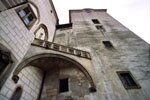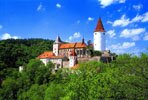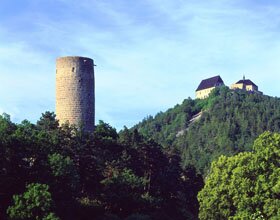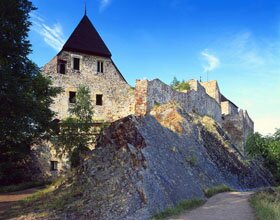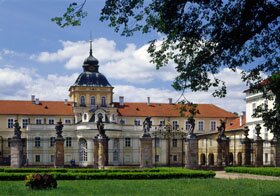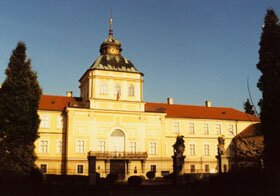Map:
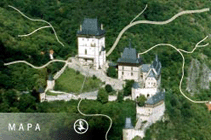
Castles and Chateaus in the neighborhood
Křivoklát
The history of one of the most widely known and oldest Czech castles dates back into twelfth century. Its existence is surrounded by legends as well as truthful tragic events. The castle caught fire several times, served as a prison and had a dungeon and a torture chamber. Only when the minds of the owners were captured by Romantism had they realized the historical value of their mansion. This meant a reconstruction of Křivoklát. The part of the tour is the castle chapel, library with incredible fifty two thousand volumes, hunting collection and the black kitchen. Křivoklát is from time to time accessible during the night. His fortifications concealed in faint light of lanterns bring us back into dark medieval times.
Žebrák a Točník
Ruins of once the most majestic complex of castles dominate the Castle hill (Zámecká hora). The older one crouches under the rock. It was founded in thirteenth century and it is called Žebrák (the beggar). Even Charles IV liked the castle. However his firstborn son Wenceslas died there and the king never returned to the place of sadness. It is said that the castle gained the name after a student who wondered the world. He played the lute and lived from what was given to him by townsfolk and nobles from castles. The knight Buzic founded the castle saying that he would name it after the first visitor. And this first visitor was that young beggar. Nový Točník (new turner) was built after the fire of Žebrák. It did not just serve as a recreation centre for kings who went hunting into local forests. The building connected great intentions (defense capabilities) and esthetics. As a result it served as a prestigious residency. The ruler entertained guests in majestic chambers. The greatest was on the second floor and was even larger than chambers in Karlstejn, Křivoklát or even the Prague castle.
Hořovice
If you wish to know what an “automatafon” is, you should visit the castle in Hořovice. In this baroque-classicist building several of these playing machines are exhibited. You will also get a chance to see the historical dining room, hunter’s saloon and a unique exhibition of cast iron. The castle was built quite late – in eighteenth century. However its historical roots go back into much further past. Archeological discoveries prove that this area was inhabited since the tenth century. The farmstead which later became a fortress, stronghold and finally a castle was built at the turn of twelfth and thirteenth century.
Březnice
The original gothic fortress was rebuilt into a renaissance castle at the turn of sixteenth and seventeenth century by Jiří Lokšan of Lokšany. By the way, from this era comes the Library of Lokšany (Lokšanská knihovna) – the oldest renaissance library in Czech Republic. There is a rumor about the founder of the castle. When he had to escape from Březnice because of Ferdinand II, he hid a great treasure under a rosebush. He hoped to one day return to the castle, dig up the valuables and live happily ever after. It did not work out this way. After the battle on White hill (Bílá hora) the castle was given to the royal prosecutor Přibík Jeníšek of Újezd. He was a loyal catholic. He did a costly reconstruction of the castle and founded a temple in the village. Simple people considered these facts and came to a conclusion that he had to find the hidden treasure. The “evidence” for this tale is a portrait of Jeníšek and his wife hanging over the doorway of the Březnice temple. The man clasps in his hand a key and his wife holds a twig of the rosebush.
X41 | X-Yachts

